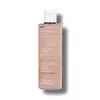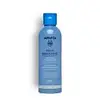What's inside
What's inside
 Key Ingredients
Key Ingredients

 Benefits
Benefits

 Concerns
Concerns

No concerns
 Ingredients Side-by-side
Ingredients Side-by-side

Water
Skin ConditioningMethyl Gluceth-20
HumectantAcrylates/C10-30 Alkyl Acrylate Crosspolymer
Emulsion StabilisingAmmonium Acryloyldimethyltaurate/Beheneth-25 Methacrylate Crosspolymer
Emulsion StabilisingBiotin
AntiseborrhoeicCaprylyl Glycol
EmollientCarbomer
Emulsion StabilisingCitric Acid
BufferingCucumis Sativus Fruit Extract
EmollientGlycerin
HumectantHelianthus Annuus Seed Oil
EmollientImperata Cylindrica Root Extract
Skin ConditioningLactic Acid
BufferingLonicera Caprifolium Flower Extract
PerfumingLonicera Japonica Flower Extract
Skin ConditioningLysolecithin
EmulsifyingPanthenol
Skin ConditioningPullulan
Rosa Canina Fruit Extract
AstringentRosa Canina Fruit Oil
EmollientRosmarinus Officinalis Extract
AntimicrobialSclerotium Gum
Emulsion StabilisingSilica
AbrasiveSodium Citrate
BufferingSodium Phytate
Tocopherol
AntioxidantXanthan Gum
EmulsifyingSodium Benzoate
MaskingParfum
MaskingWater, Methyl Gluceth-20, Acrylates/C10-30 Alkyl Acrylate Crosspolymer, Ammonium Acryloyldimethyltaurate/Beheneth-25 Methacrylate Crosspolymer, Biotin, Caprylyl Glycol, Carbomer, Citric Acid, Cucumis Sativus Fruit Extract, Glycerin, Helianthus Annuus Seed Oil, Imperata Cylindrica Root Extract, Lactic Acid, Lonicera Caprifolium Flower Extract, Lonicera Japonica Flower Extract, Lysolecithin, Panthenol, Pullulan, Rosa Canina Fruit Extract, Rosa Canina Fruit Oil, Rosmarinus Officinalis Extract, Sclerotium Gum, Silica, Sodium Citrate, Sodium Phytate, Tocopherol, Xanthan Gum, Sodium Benzoate, Parfum
Water
Skin ConditioningPropanediol
SolventXylitylglucoside
HumectantPentylene Glycol
Skin ConditioningPropolis Extract
Skin ConditioningRosa Canina Fruit Extract
AstringentAloe Barbadensis Leaf Juice Powder
Skin ConditioningHoney
HumectantChlorella Vulgaris Extract
Skin ConditioningCistus Incanus Flower/Leaf/Stem Extract
Skin ConditioningIris Versicolor Extract
EmollientPEG-60 Almond Glycerides
EmulsifyingSodium Hyaluronate
HumectantGlycerin
HumectantAllantoin
Skin ConditioningPanthenol
Skin ConditioningInulin
Skin ConditioningAnhydroxylitol
HumectantHydroxyacetophenone
AntioxidantXylitol
HumectantFructose
HumectantTetrasodium Glutamate Diacetate
Citric Acid
BufferingHydroxypropyl Cyclodextrin
MaskingSaccharide Hydrolysate
HumectantLactic Acid
BufferingCaprylyl Glycol
Emollient1,2-Hexanediol
Skin ConditioningWater, Propanediol, Xylitylglucoside, Pentylene Glycol, Propolis Extract, Rosa Canina Fruit Extract, Aloe Barbadensis Leaf Juice Powder, Honey, Chlorella Vulgaris Extract, Cistus Incanus Flower/Leaf/Stem Extract, Iris Versicolor Extract, PEG-60 Almond Glycerides, Sodium Hyaluronate, Glycerin, Allantoin, Panthenol, Inulin, Anhydroxylitol, Hydroxyacetophenone, Xylitol, Fructose, Tetrasodium Glutamate Diacetate, Citric Acid, Hydroxypropyl Cyclodextrin, Saccharide Hydrolysate, Lactic Acid, Caprylyl Glycol, 1,2-Hexanediol
Alternatives
Ingredients Explained
These ingredients are found in both products.
Ingredients higher up in an ingredient list are typically present in a larger amount.
Caprylyl Glycol is a humectant and emollient, meaning it attracts and preserves moisture.
It is a common ingredient in many products, especially those designed to hydrate skin. The primary benefits are retaining moisture, skin softening, and promoting a healthy skin barrier.
Though Caprylyl Glycol is an alcohol derived from fatty acids, it is not the kind that can dry out skin.
This ingredient is also used as a preservative to extend the life of products. It has slight antimicrobial properties.
Learn more about Caprylyl GlycolCitric Acid is an alpha hydroxy acid (AHA) naturally found in citrus fruits like oranges, lemons, and limes.
Like other AHAs, citric acid can exfoliate skin by breaking down the bonds that hold dead skin cells together. This helps reveal smoother and brighter skin underneath.
However, this exfoliating effect only happens at high concentrations (20%) which can be hard to find in cosmetic products.
Due to this, citric acid is usually included in small amounts as a pH adjuster. This helps keep products slightly more acidic and compatible with skin's natural pH.
In skincare formulas, citric acid can:
While it can provide some skin benefits, research shows lactic acid and glycolic acid are generally more effective and less irritating exfoliants.
Most citric acid used in skincare today is made by fermenting sugars (usually from molasses). This synthetic version is identical to the natural citrus form but easier to stabilize and use in formulations.
Read more about some other popular AHA's here:
Learn more about Citric AcidGlycerin is already naturally found in your skin. It helps moisturize and protect your skin.
A study from 2016 found glycerin to be more effective as a humectant than AHAs and hyaluronic acid.
As a humectant, it helps the skin stay hydrated by pulling moisture to your skin. The low molecular weight of glycerin allows it to pull moisture into the deeper layers of your skin.
Hydrated skin improves your skin barrier; Your skin barrier helps protect against irritants and bacteria.
Glycerin has also been found to have antimicrobial and antiviral properties. Due to these properties, glycerin is often used in wound and burn treatments.
In cosmetics, glycerin is usually derived from plants such as soybean or palm. However, it can also be sourced from animals, such as tallow or animal fat.
This ingredient is organic, colorless, odorless, and non-toxic.
Glycerin is the name for this ingredient in American English. British English uses Glycerol/Glycerine.
Learn more about GlycerinLactic Acid is another well-loved alpha hydroxy acid (AHA). It is gentler than glycolic acid but still highly effective.
Its main role is to exfoliate the surface of the skin by loosening the “glue” that holds dead skin cells together. Shedding those old cells leads to smoother, softer, and more even-toned skin.
Because lactic acid molecules are larger than glycolic acid, they don’t penetrate as deeply. This means they’re less likely to sting or irritate, making it a great choice for beginners or those with sensitive skin.
Like glycolic acid, it can:
Lactic acid also acts as a humectant (like hyaluronic acid). It can draw water into the skin to improve hydration and also plays a role in the skin's natural moisturizing factor (NMF) in the form of sodium lactate.
Studies show it can boost ceramide production to strengthen the skin barrier and even help balance the skin’s microbiome.
To get results, choose products with a pH between 3-4.
Lower strengths (5-12%) focus on surface exfoliation; higher strengths (12% and up) can reach deeper in the dermis (deeper, supportive layer) to improve skin texture and firmness over time.
Though it was originally derived from milk, most modern lactic acid used in skincare is vegan. It is made through non-dairy fermentation to create a bio-identical and stable form suitable for all formulations.
When lactic acid shows up near the end of an ingredient list, it usually means the brand added just a tiny amount to adjust the product’s pH.
Legend has it that Cleopatra used to bathe in sour milk to help reduce wrinkles.
Lactic acid is truly a gentle multitasker: it exfoliates, hydrates, strengthens, and brightens. It's a great ingredient for giving your skin a smooth, glowing, and healthy look without the harshness of stronger acids.
Read more about some other popular AHA's here:
Learn more about Lactic AcidPanthenol is a common ingredient that helps hydrate and soothe the skin. It is found naturally in our skin and hair.
There are two forms of panthenol: D and L.
D-panthenol is also known as dexpanthenol. Most cosmetics use dexpanthenol or a mixture of D and L-panthenol.
Panthenol is famous due to its ability to go deeper into the skin's layers. Using this ingredient has numerous pros (and no cons):
Like hyaluronic acid, panthenol is a humectant. Humectants are able to bind and hold large amounts of water to keep skin hydrated.
This ingredient works well for wound healing. It works by increasing tissue in the wound and helps close open wounds.
Once oxidized, panthenol converts to pantothenic acid. Panthothenic acid is found in all living cells.
This ingredient is also referred to as pro-vitamin B5.
Learn more about PanthenolRosa Canina Fruit Extract is from Rosehip. Rosehips are a fruit from a wild rose bush native to Eurasia and Africa.
Rosehip contains Vitamin C, Vitamin E, fatty acids and linolenic acids that hydrate skin. Having hydrated skin helps reduce the appearance of fine-lines and wrinkles.
Vitamins C and E are potent antioxidants and may help with anti-aging. The fatty acids are emollients that help soften and hydrate your skin.
Another potent vitamin found in rosehip is Vitamin A, or retinol. Retinol encourages collagen production in the skin.
Rosehip extract may help with brightening the skin. Several components, such as beta-carotene, are able to reduce pigmentation caused by sun damage.
Learn more about Rosa Canina Fruit ExtractWater. It's the most common cosmetic ingredient of all. You'll usually see it at the top of ingredient lists, meaning that it makes up the largest part of the product.
So why is it so popular? Water most often acts as a solvent - this means that it helps dissolve other ingredients into the formulation.
You'll also recognize water as that liquid we all need to stay alive. If you see this, drink a glass of water. Stay hydrated!
Learn more about Water